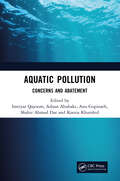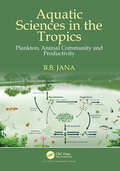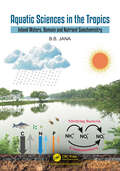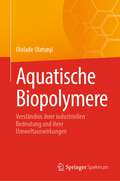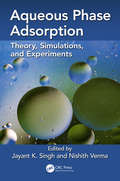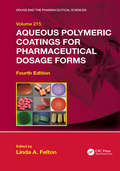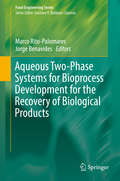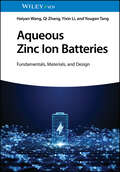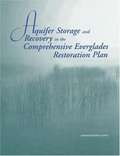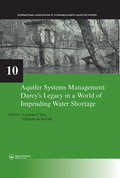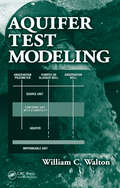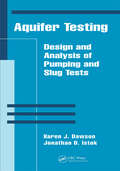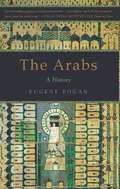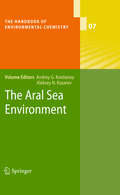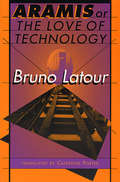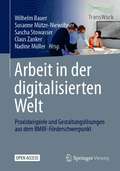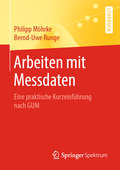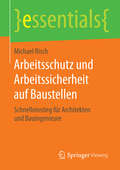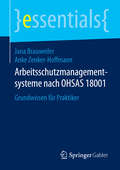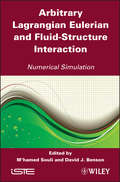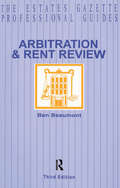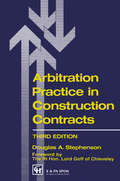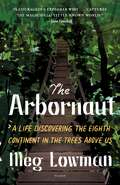- Table View
- List View
Aquatic Pollution: Concerns and Abatement
by Imtiyaz Qayoom Adnan Abubakr Anu Gopinath Shabir A. Dar Keezia KhurshidThis book discusses the sources, mechanism, impact and abatement of pollution in waterbodies and lays a base foundation for further research. In this book, readers will also get acquainted with the methods of decontamination of lakes by phytoremediation, pesticide removal techniques from lakes, toxic site reclamation and environmental sustainability using microbial aspects associated with clean-up of wastes.Based on the issues related to pollution of aquatic environments, the subject matter of this book includes: Nanoplastic Pollutants Affecting Fisheries Sector All Over the World Freshwater Floral Diversities as Pollution Indicators Radioactive Waste: Sources and Impact on Environment Environmental Sustainability Using Microbial Aspects Associated With Clearing Up Waste Nitrates and Phosphates: Boon or Bane for Waterbodies Print edition not for sale in South Asia (India, Sri Lanka, Nepal, Bangladesh, Pakistan and Bhutan)
Aquatic Sciences in the Tropics: Plankton, Animal Community and Productivity
by B. B. JanaThe anatomy of water, water as a substance, water as a medium, the principles of the hydrologic cycle, the economics of water, and challenges are all covered in the first chapter of this book. The horizon of the tropical world, the environment, particularly the tropical environment, aquatic biome, tropical aquatic bionetwork, concept of biosphere, and tropical limnology are all covered in the second chapter. The third chapter covers the following topics: the origins of lakes, general lake classification, tropical lakes, lake morphometry, morpho-edaphic index, trophic status index of lakes, wetlands, and mangroves in tropical regions. The lotic environment is the main topic of the fourth chapter, which also covers the idea of stream order, the differences between rivers and streams, the river continuum, physical, chemical, and biological characteristics, and adaptations of fish found in hill streams. Chapter five covers the prokaryota, cyanobacteria, freshwater biota, and water-adapted organisms. The sixth chapter focuses on the algal communities Xanthophyceae, Euglenophyceae, Bacillariophyceae, Chrysophyceae, Phaeophyceae (brown algae), and Chlorophyceae. The seventh and last chapter covers the following topics: Protozoa, Porifera, Rotifera, Coelenterata, Annelida, Arthropoda, Crustacea, Aquatic Insects, Mollusca, Echinodermata, and Brachiopodaa.
Aquatic Sciences in the Tropics: Inland Waters, Domain and Nutrient Geochemistry
by B.B. JanaThe tropical environment is unique due to its geographic location, climatic features, intense solar radiation, high temperature, heavy precipitation, less seasonal variation, enhanced food and productivity, faster metabolism, ecological dynamics and co-evolutionary processes that favor niches for specialized species. It also provides the richest biodiversity with endemic fish species that support millions of people in rural areas. This book Aquatic Sciences in the Tropics: Inland Waters, Domain and Nutrient Geochemistry comprises nine primary chapters that address various topics. Chapter 1 covers topics such as Water as a Substance, Water as a Medium, Fundamentals of Global Water Distribution and Hydrologic Cycle, Economics of Water and Challenges; Chapter 2: The Environment, Tropical Environment, Concept of Biosphere and Aquatic Biome, Tropical Aquatic Bionetwork, Tropical Limnology; Chapter 3: Origin of Lakes, General Classification of Lakes, Tropical Lakes, Lake Morphometry, Morpho-Edaphic Index, Trophic State Index of Lakes, Wetlands, Mangroves; Chapter 4: Concept of Stream Order, Streams and Rivers, The River Continuum Concept, Physico-chemical and Biological Features of Streams, Adaptations of Hill Stream Fishes; Chapter 5: Light as an Entity, Thermal Regime, Thermal Stratification, Lake Mixing, Turnover and Circulation; Chapter 6: Sources of CO2 in Inland Waters, Hydrogen Ion Concentration, The CO2–CO3–HCO3 System, Alkalinity, Hardness; Chapter 7: Dissolved Oxygen, Oxidation and Reduction Potential; Chapter 8: Total Dissolved Solids, Dissolved Organic Carbon; Chapter 9: Origin of Atmospheric Gases, Carbon and Carbon Cycle, Nitrogen, Nitrogen Fixation, Ammonification, Nitrification and Comammox, Denitrification and Anammox, Phosphorus and Sulphur.It is anticipated that the academic community, students, teachers, instructors, researchers, colleges, universities, institutions, administrators, policy makers, public libraries and the general public with an interest in these topics will find this text to be a valuable source of information and provide in-depth knowledge.
Aquatische Biopolymere: Verständnis ihrer industriellen Bedeutung und ihrer Umweltauswirkungen
by Ololade OlatunjiDieses Buch gibt einen umfassenden Überblick über die jüngsten Entwicklungen bei industriellen Anwendungen, Verarbeitungstechniken und Modifikationen von Polymeren aus marinen Quellen. Es führt den Leser systematisch in die Biomaterialien Chitin, Kollagen, Alginate, Cellulose und Polyester ein und stellt eine Verbindung zwischen ihrer industriellen Bedeutung und ihren Auswirkungen auf die Umwelt her. Das Buch verdeutlicht die Auswirkungen der industriellen Nutzung des aquatischen Systems für organische und anorganische Stoffe auf die Umwelt und vertieft das Verständnis der industriellen und wirtschaftlichen Bedeutung aquatischer Biopolymere. Darüber hinaus geht es um die Frage, wie die Erhaltung des aquatischen Lebens und das industrielle und wirtschaftliche Interesse an der Entwicklung biologisch abbaubarer Alternativen für Kunststoffe in Einklang gebracht werden können. Das Buch richtet sich daher an Wissenschaftler:innen aus den Bereichen Chemie, Material- und Polymerwissenschaften sowie Ingenieurwesen.
Aqueous Phase Adsorption: Theory, Simulations and Experiments
by Jayant Singh Nishith VermaThis book covers theoretical aspects of adsorption, followed by an introduction to molecular simulations and other numerical techniques that have become extremely useful as an engineering tool in recent times to understand the interplay of different mechanistic steps of adsorption. Further, the book provides brief experimental methodologies to use, test, and evaluate different types of adsorbents for water pollutants. Through different chapters contributed by accomplished researchers working in the broad area of adsorption, this book provides the necessary fundamental background required for an academician, industrial scientist or engineer to initiate studies in this area. Key Features Explores fundamentals of adsorption-based separation Provides physical insight into aqueous phase adsorption Includes theory, molecular and mesoscopic level simulation techniques and experiments Describes molecular simulations and lattice-Boltzmann method based models for aqueous phase adsorption Presents state-of-art experimental works particularly addressing removal of "emerging pollutants" from aqueous phase
Aqueous Polymeric Coatings for Pharmaceutical Dosage Forms (Drugs and the Pharmaceutical Sciences)
by Linda A. FeltonAqueous-based film coating has become routine in the pharmaceutical industry. This process eliminates the use of organic solvents and thus avoids economic, environmental, and toxicological issues related to residual solvents and solvent recovery. Aqueous-based coating, however, is complex and many variables may impact the final product and its performance. This fourth edition of Aqueous Polymeric Coatings for Pharmaceutical Dosage Forms aims to provide insight into the factors and parameters that should be considered and controlled for the successful development and commercialization of a coated product. The fourth edition has been revised and expanded to reflect the most recent scientific advancements from the literature. The contributing authors explain in detail, using illustrated examples, appropriate steps to solve and ideally avoid formulation, processing, and stability problems and to achieve an optimized dosage form. Trade names and chemical names of commercially marketed coatings are used throughout the text to help familiarize the reader with the various materials available for pharmaceutical applications. This book will be a valuable resource for anyone in the pharmaceutical industry working in the area of aqueous-based film coating.
Aqueous Two-Phase Systems for Bioprocess Development for the Recovery of Biological Products (Food Engineering Series)
by Marco Rito-Palomares Jorge BenavidesThis comprehensive and unique text presents a full overview of downstream processing useful for those new to the concept as well as professionals with experience in the area. The history and theoretical principles of Aqueous Two-Phase Systems (ATPS) are covered in depth. Information on ATPS characterization and application is included, and ATPS equilibria and system parameters that have significant effect on partition behavior are studied. Aqueous Two-Phase Systems for Bioprocess Development for the Recovery of Biological Products addresses specific applications of ATPS for the recovery and partial purification of high molecular weight compounds such as proteins, nucleic acids and polysaccharides, particulate bioproducts such as cells and organelles and low molecular weight compounds. Non-conventional strategies involving ATPS such as affinity systems, continuous liquid-liquid fractionation stages and the recovery from plant extracts are presented. Economic analysis of the application of ATPS in comparison to other fractionation techniques, particularly liquid chromatography, is considered, as are opportunity and current trends in the ATPS research area. Each chapter utilizes the contributors' experimental expertise in traditional and non-conventional ATPS strategies, as well as analysis of areas of opportunity and perspectives on the development and future applications of ATPS in both the lab and larger scale operations. The result is a thorough and singular overview of ATPS which has not been matched by any other text on the market.
Aqueous Zinc Ion Batteries: Fundamentals, Materials, and Design
by Haiyan Wang Qi Zhang Yixin Li Yougen TangAqueous Zinc Ion Batteries Pioneering reference book providing the latest developments and experimental results of aqueous zinc ion batteries Aqueous Zinc Ion Batteries comprehensively reviews latest advances in aqueous zinc ion batteries and clarifies the relationships between issues and solutions for the emerging battery technology. Starting with the history, the text covers essentials of each component of aqueous zinc ion batteries, including cathodes, anodes, and electrolytes, helping readers quickly attain a foundational understanding of the subject. Written by three highly qualified authors with significant experience in the field, Aqueous Zinc Ion Batteries provides in-depth coverage of sample topics such as: History, main challenges, and zinc metal anodes for aqueous zinc ion batteriesElectrochemical reaction mechanism of aqueous zinc ion batteries and interfacial plating and stripping on zinc anodesCathode materials for aqueous zinc ion batteries, covering manganese-based materials, vanadium-based materials, Prussian blue analogs, and other cathode materialsDevelopment of electrolytes, issues, and corresponding solutions for aqueous zinc ion batteries Separators for aqueous zinc ion batteries, development of full zinc ion batteries, and future perspectives on the technology A detailed resource on a promising alternative to current lithium-ion battery systems, Aqueous Zinc Ion Batteries is an essential read for materials scientists, electrochemists, inorganic chemists, surface chemists, catalytic chemists, and surface physicists who want to be on the cutting edge of a promising new type of battery technology.
Aquifer Storage and Recovery in the Comprehensive Everglades Restoration Plan: A Critique of the Pilot Projects and Related Plans for ASR in the Lake Okeechobee and Western Hillsboro Areas
by National Research CouncilA report on Aquifer Storage and Recovery in the Comprehensive Everglades Restoration Plan.
Aquifer Systems Management: Selected Papers on Hydrogeology 10 (IAH - Selected Papers on Hydrogeology)
by Laurence Chery Ghislain De MarsilyPresented at the International Association of Hydrogeologists Dijon Symposium, this book contains 43 selected papers, grouped into six topics, that address the following issues: large aquifers, resource assessment; large aquifers, water salinity and evolution; karstic and carbonate aquifer systems; geothermal aquifer systems; aquifer contamination studies; and aquifer monitoring systems and management. In celebration of the 150th anniversary of the publication of Darcy's Law, the volume includes a summary of Darcy's life and his contribution to science, and five invited contributions on modern methods to estimate the hydraulic conductivity of aquifers.
Aquifer Test Modeling
by William C. WaltonIn recognition of the trend toward using numerical methdos for analyzing aquifer test data, Aquifer Test Modeling delineates the application of numerical Laplace inversion analytical equations and numerical models and demonstrates the use of public domain software. Written by a leading expert with over fifty years of experience, this highly practic
Aquifer Testing: Design and Analysis of Pumping and Slug Tests
by Jonathan D. Istok Karen J. DawsonNew! A practical, easy-to-use reference for the design and analysis of groundwater pumping and slug testsAquifer Testing: Design and Analysis of Pumping and Slug Tests is a complete design and analysis reference emphasizing practical solutions for engineers, scientists, consultants, and students knowledgeable in basic ground water theory. T
The Arabs
by Eugene RoganTo American observers, the Arab world often seems little more than a distant battleground characterized by religious zealotry and political chaos. Years of tone-deaf US policies have left the region powerless to control its own destiny-playing into a longstanding sense of shame and impotence for a once-mighty people. In this definitive account, preeminent historian Eugene Rogan traces five centuries of Arab history, from the Ottoman conquests through the British and French colonial periods and up to the present age of unipolar American hegemony. The Arab world is now more acutely aware than ever of its own vulnerability, and this sense of subjection carries with it vast geopolitical consequences. Drawing from Arab sources little known to Western readers, Rogan’sThe Arabswill transform our understanding of the past, present, and future of one of the world’s most tumultuous regions.
The Aral Sea Environment
by Aleksey N. Kosarev Andrey G. KostianoyThe environmental problems in the Aral Sea region continue to worsen. This volume presents the information gathered to date on various aspects of the Aral Sea environment. Specialists from institutions in Russia, Uzbekistan, France, Germany and the USA cover different topics - from the paleohistory and archaeology of the region, to the present physical, chemical and biological state of the sea, and the analysis of the runoff and deltas of the Amudarya and Syrdarya rivers. Further, the regional climate change is discussed and reasons for the progressing environmental crisis and the socio-economic problems in the region are highlighted. The Aral Sea Environment is addressed to scientists working in the fields of physical oceanography, marine chemistry, biology, and the environmental sciences.
Aramis, or the Love of Technology
by Bruno LatourBruno Latour has written a unique and wonderful tale of a technological dream gone wrong. As the young engineer and professor follow Aramis' trail--conducting interviews, analyzing documents, assessing the evidence--perspectives keep shifting: the truth is revealed as multilayered, unascertainable, comprising an array of possibilities worthy of Rashomon. The reader is eventually led to see the project from the point of view of Aramis, and along the way gains insight into the relationship between human beings and their technological creations. This charming and profound book, part novel and part sociological study, is Latour at his thought-provoking best.
Arbeit in der digitalisierten Welt: Praxisbeispiele und Gestaltungslösungen aus dem BMBF-Förderschwerpunkt
by Wilhelm Bauer Susanne Mütze-Niewöhner Sascha Stowasser Claus Zanker Nadine MüllerDas vorliegende Open-Access-Buch umfasst Beiträge aus 29 Verbundvorhaben sowie dem begleitenden Verbundprojekt „TransWork“. Im Rahmen des Förderschwerpunkts „Arbeit in der digitalisierten Welt“ des Bundesministeriums für Bildung und Forschung wurden in den Projekten Entwicklungen im Transformationsprozess der Arbeitswelt analysiert, Lösungsansätze entwickelt und diese wissenschaftlich begleitet. In den Beiträgen werden Einblicke in die erarbeiteten Erkenntnisse und entwickelten Konzepte der Projekte gegeben. Hieraus lassen sich für Akteure aus Politik und Wirtschaft Handlungsempfehlungen ableiten und es ergeben sich neue Forschungsimpulse für die Wissenschaft.
Arbeiten mit Messdaten: Eine praktische Kurzeinführung nach GUM
by Philipp Möhrke Bernd-Uwe RungeDas vorliegende Lehrbuch bietet Studierenden der Natur- und Ingenieurswissenschaften einen übersichtlichen und anschaulichen Einstieg in den Umgang mit Messdaten und deren Interpretation unter Verwendung der Messunsicherheit – früher oft Fehlerrechnung genannt. Dabei stehen das Verständnis und die Vermittlung von direkt anwendbarem Wissen im Vordergrund. Auf lange mathematische Herleitungen wird weitgehend verzichtet.Auf Basis einiger einfacher Grundprinzipien wie der Verteilung der Messwerte oder dem mathematischen Modell einer Messung führt dieses Buch in zentrale Themen ein:- das Messen an sich,- die Angabe von Messergebnissen,- das Konzept der Unsicherheit,- die Auswertung von Messdaten mittels verschiedener Methoden,- sowie die Bewertung der erhaltenen Ergebnisse.Alle diese Themen werden anhand vielfältiger Beispiele ausführlich dargestellt und die Anwendung der abstrakten Konzepte anhand konkreter Zahlenbeispiele veranschaulicht. Fragen zur Selbstkontrolle sowie zur Vertiefung der Inhalte runden jedes Kapitel ab.
Arbeitsschutz und Arbeitssicherheit auf Baustellen: Schnelleinstieg für Architekten und Bauingenieure (essentials)
by Michael RischMichael Risch beschreibt, wie man Baustellen sicherergestaltet, die eigene Verantwortung erkennt und damit das Unfall- undHaftungsrisiko reduziert. Ausgehend von den realen Erfordernissen an dieArbeitssicherheit unterstützt der Autor so bei der Einordnung, Wertung undAnwendung von Vorschriften und Regeln zur Unfallvermeidung und zumArbeitsschutz auf Baustellen. Auf dieser Grundlage wird der Leser befähigt,diese auf den jeweiligen Sachverhalt in der Praxis zu übertragen und sinnvolldanach zu handeln. Die Planung komplexer Gebäuden sollte mit einer möglichstgenauen Kenntnis der tatsächlichen Bauabläufe Hand in Hand gehen, denn nur sokann bereits im Planungsprozess eine vorausschauende Gefährdungsbeurteilung fürdie Bauausführung erfolgen. Mit der Inbetriebnahme und Nutzung eines Gebäudes mussauch dessen Wartung, Pflege und Instandhaltung sicher und ungefährdet durchführbarsein, was im Planungsprozess zu berücksichtigen und in der Bauausführungumzusetzen ist.
Arbeitsschutzmanagementsysteme nach OHSAS 18001: Grundwissen für Praktiker (essentials)
by Jana Brauweiler Anke Zenker-HoffmannJana Brauweiler und Anke Zenker-Hoffmann stellen in diesem Essential Anforderungen an Arbeitsschutzmanagementsysteme (AMS) nach der Occupational Health Safety Assessment Series 18001 (OHSAS 18001) vor. Die Autorinnen definieren Begriffe und systematisieren die vorhandenen Konzepte zur Einführung eines AMS nach Gestaltungsebenen. Da von den Konzepten die internationale Norm OHSAS 18001 in der internationalen Verbreitung eine führende Rolle einnimmt, erläutern sie an diesem Beispiel ausführlich die Anforderungen an ein AMS nach den Phasen des Managementkreislaufes plan-do-check-act und unterlegen diese, wo möglich, mit Beispielen.
Arbitrary Lagrangian Eulerian and Fluid-Structure Interaction: Numerical Simulation (Wiley-iste Ser.)
by M'Hamed Souli David J. BensonThis book provides the fundamental basics for solving fluid structure interaction problems, and describes different algorithms and numerical methods used to solve problems where fluid and structure can be weakly or strongly coupled. These approaches are illustrated with examples arising from industrial or academic applications. Each of these approaches has its own performance and limitations. Given the book’s comprehensive coverage, engineers, graduate students and researchers involved in the simulation of practical fluid structure interaction problems will find this book extremely useful.
Arbitrary Modeling of TSVs for 3D Integrated Circuits (Analog Circuits and Signal Processing)
by Khaled Salah Yehea Ismail Alaa El-RoubyThis book presents a wide-band and technology independent, SPICE-compatible RLC model for through-silicon vias (TSVs) in 3D integrated circuits. This model accounts for a variety of effects, including skin effect, depletion capacitance and nearby contact effects. Readers will benefit from in-depth coverage of concepts and technology such as 3D integration, Macro modeling, dimensional analysis and compact modeling, as well as closed form equations for the through silicon via parasitics. Concepts covered are demonstrated by using TSVs in applications such as a spiral inductor and inductive-based communication system and bandpass filtering.
The Arbitration Act 1996
by Bruce Harris Jonathan Tecks Rowan PlanteroseThe most readable, useful, practical and user-friendly guide to the Arbitration Act 1996.The Arbitration Act 1996 is a section by section commentary on the Act, which Lord Bingham described as "intensely practical and admirably user-friendly" when it was first published. The fifth edition has been updated by considering in excess of 300 new cases decided since publication of the 4th edition. In addition there have been some significant changes to the Model Law since publication of the previous edition, (which take it into areas where UK arbitration does not go), and these changes are documented, updated and commented upon. In previous editions, the authors have limited themselves to mentioning states conclusively declared to be parties to the New York Convention by Order in Council. This tends to follow some way behind the current position, however, so a more comprehensive coverage of states which are parties to the New York Convention is included. The result is a thorough update, providing the most readable and useful guide to the Act. provides a section by section commentary on the Act and covers all the key casespublished in conjunction with the Chartered Institute of Arbitrators and used by them as a recommended training textthe bestseller of the four original guides to the 1996 Actwritten by three practising arbitrators, two of whom are also practising barristers'There should not be a practitioner who does not have a copy...highly recommended.' - Arbitration
Arbitration and Rent Review
by Ben BeaumontArbitration and Rent Review has become a standard work in the property world for guidance on rent review. In a clear style, the author examines the procedures that landlord and tenant should follow in order to agree a new rent or to have one decided by arbitration. By means of cases, he highlights the key areas of conflict that come before the courts, the contentious issues being introduced in the order in which they would be encountered by landlords or tenancts facing a review.
Arbitration Practice in Construction Contracts
by D.A. StephensonConsiders each stage in the course of an arbitration in detail, from the claimant's decision to seek the means of resolving a dispute to the arbitrator's award, explaining clearly and concisely what is expected of the claimant, respondent and arbitrator and when.
The Arbornaut: A Life Discovering the Eighth Continent in the Trees Above Us
by Meg Lowman“An eye-opening and enchanting book by one of our major scientist-explorers.” —Diane Ackerman, author of The Zookeeper’s WifeNicknamed the “Real-Life Lorax” by National Geographic, the biologist, botanist, and conservationist Meg Lowman—aka “CanopyMeg”—takes us on an adventure into the “eighth continent” of the world's treetops, along her journey as a tree scientist, and into climate actionWelcome to the eighth continent!As a graduate student exploring the rain forests of Australia, Meg Lowman realized that she couldn’t monitor her beloved leaves using any of the usual methods. So she put together a climbing kit: she sewed a harness from an old seat belt, gathered hundreds of feet of rope, and found a tool belt for her pencils and rulers. Up she went, into the trees. Forty years later, Lowman remains one of the world’s foremost arbornauts, known as the “real-life Lorax.” She planned one of the first treetop walkways and helps create more of these bridges through the eighth continent all over the world. With a voice as infectious in its enthusiasm as it is practical in its optimism, The Arbornaut chronicles Lowman’s irresistible story. From climbing solo hundreds of feet into the air in Australia’s rainforests to measuring tree growth in the northeastern United States, from searching the redwoods of the Pacific coast for new life to studying leaf eaters in Scotland’s Highlands, from conducting a BioBlitz in Malaysia to conservation planning in India and collaborating with priests to save Ethiopia’s last forests, Lowman launches us into the life and work of a field scientist, ecologist, and conservationist. She offers hope, specific plans, and recommendations for action; despite devastation across the world, through trees, we can still make an immediate and lasting impact against climate change. A blend of memoir and fieldwork account, The Arbornaut gives us the chance to live among scientists and travel the world—even in a hot-air balloon! It is the engrossing, uplifting story of a nerdy tree climber—the only girl at the science fair—who becomes a giant inspiration, a groundbreaking, ground-defying field biologist, and a hero for trees everywhere.Includes black-and-white illustrations
